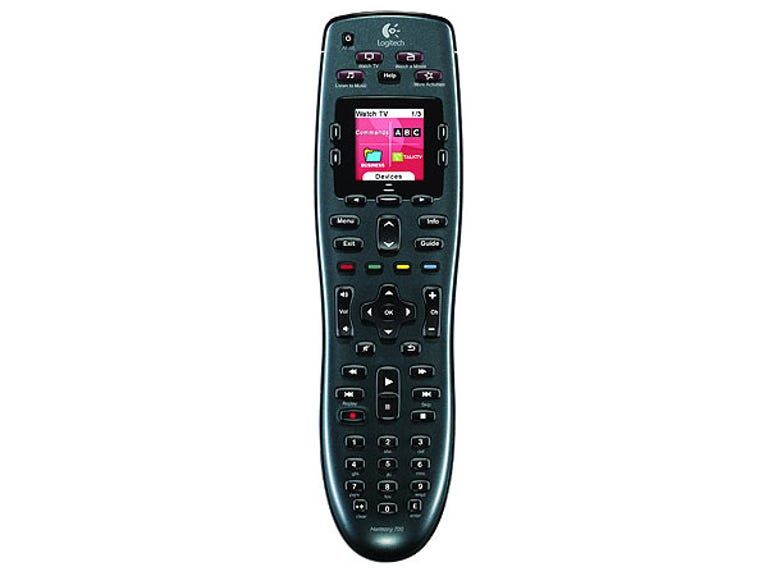 Why You Can Trust CNET
Why You Can Trust CNET Logitech Harmony 700 review: Logitech Harmony 700
The Harmony 700 is a fine remote, but Logitech's older universal remotes outclass it in features and value.
The Good
The Bad
The Bottom Line
Design
We're normally a bit critical of busy remote controls, simply because extra buttons usually mean a much tougher learning curve, along with the distinct possibility that you've got a remote with buttons that you'll never conceivably use. We'll give Logitech's Harmony 700 something of a pass in this regard, simply because as a universal remote, there's a few more buttons on it that you might actually want.
The latest in Logitech's long-running Harmony remote series looks very similar to existing models. A small 1-inch LCD screen sits at the top, but unlike models such as the Harmony One, this isn't a touchscreen, it's just a display for showing two TV-centric activities at a time. Above the screen are dedicated buttons for the kinds of activities Logitech presumes most TV fanatics will want to engage in — Watching TV, Movies, Listening to Music and a button labelled "More Activities" that acts in much the same way as the "Activities" button on previous Harmony remotes have done.
Features
We've always rated Logitech's button-based Harmony remotes well at CNET. The same isn't entirely true of the company's entirely touchscreen-based models such as the Harmony 1100i, which have always hit a difficult price and usability point. Still, the engine that makes the entire Harmony range sing is still very much present in the Harmony 700, and that's the simple web-based interface for setting up the remote itself. The Harmony database claims it knows the IR codes for around 225,000 devices, and it's possible to add more if you've got the original remote for a model it doesn't know to hand.
The Harmony remote software may be the same, but it's tough to look at the Harmony 700 itself and not view it as the rather stupid cousin of existing older Harmony models. It's only capable of controlling a total of six devices, compared to 15 for older models such as the Harmony One or Harmony 785. Obviously home A/V set-ups vary and six may be more than you personally need, but it's a pretty hard limit, and we're not even sure why it's a limit in the first place.
Unlike other Harmony remotes we've looked at in the past, Logitech's opted to go for rechargeable AA batteries for the Harmony 700, rather than Lithium-ion. This has some usefulness if the batteries are flat — you can always chuck in another set — but it also means that the charging is purely from a microUSB cable rather than a handy charging dock.
Performance
Setting up the Harmony 700 was a simple enough affair, as it's identical to every other Harmony remote. Install the Harmony software onto a PC or Mac, set up a Logitech account for your remote — annoyingly you can't put multiple remotes onto one account for some reason — and tell it the details of all of your home A/V gear.
We always like to test how up-to-date the Harmony database is, and in our tests the one item it didn't find was the Toshiba 22DV615Y TV. That gave us the opportunity to test its ability to pick up new remote codes, a somewhat tedious procedure. We've had to do this in the past with previous Harmony remotes from time to time, but the Harmony 700 was particularly fussy when it came to recognising IR codes until we flipped it upside down to fully reveal its IR sensor.
The Harmony 700 only displays two activities at a time, with the option to flick to other activities from the front panel, and it took us some serious time to get used to which buttons flick between activity choices and which ones launch them. For the record, the side-mounted buttons handle activity launching, while the base ones flip between activity choices. The rubber buttons on the Harmony 700 are slightly squishy, and depending on your personal choice that can either be comforting in giving a lot of responsiveness before a button press is registered, or annoying in that you have to press a bit harder than on previous plastic-buttoned models.
We're also a little puzzled why a remote control that ships for US$150 in the States demands a AU$299 price point in Australia given the current exchange rate, but that of course could change.
There's nothing patently wrong with the Harmony 700, but we still can't score it particularly high. That's not so much down to the Harmony 700 itself, but simply because there are other models still on the market that outclass it at similar or cheaper prices. The Harmony 785, for example, is strikingly similar, except for the fact that it controls 15 devices and can be had for around AU$200 less at the time of writing. Even the technically superior Harmony One, which Logitech insists RRPs for AU$499 can quite easily be purchased online or in retail stores for around AU$250, less than the Harmony 700's AU$299 retail price point. Clearly those models may well be run out and leave you with the Harmony 700 as the only entry-level Harmony model, so if you're keen on a Harmony remote to nestle under the Christmas tree this year, we'd suggest you hurry.


